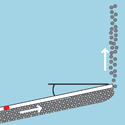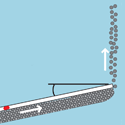Bubble bath
A wet foam—such as that on a cappuccino—and a trough of plastic beads are both made up of nearly spherical, close-packed objects, but do these two types of materials, which are neither fully liquid or solidlike, have anything in common? Experiments presented in Physical Review Letters suggest similarities between foams and granular matter that may lead to a more unified theory for describing the two materials.
A feature of granular materials distinguishing them from liquids is that they jam: the flow is arrested by clusters of grains that can’t reconfigure, like cars merging out of a closed lane. Unlike grains, however, bubbles aren’t hard and slip past each other easily, so it isn’t clear they should behave in a similar way.
Rémi Lespiat and colleagues at the Université Paris-Est, France, have designed a microfluidic chamber to study foams made from nitrogen bubbles in water containing a small amount of surfactant. They let a controlled amount of the bubble mixture rise up onto the bottom surface of a smooth plate, which is bounded on the sides and submerged in the liquid. The plate is tilted up, so buoyancy drives the closely packed gas bubbles upwards along its bottom surface, much as gravity would drive solid grains poured on the top surface downwards.
This setup, with which the team can track the jamming or flow of the bubbles, depending on plate inclination, allows Lespiat et al. to make a direct comparison between grainy matter and foams. – Jessica Thomas





